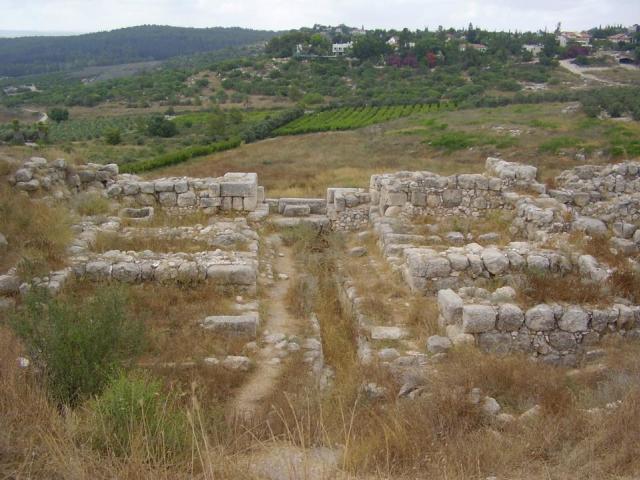Israel: Ancient Human Remains Discovered in Biblical City 3,200 Years After its Destruction by the Egyptians
Science
C.paton,Newsweek 22 hours ago
Excavations of the city appeared to show how three inhabitants, two adults and a child, met a violent end after a series Egyptian pharaohs attempted to bring Gezer to heel, finally reducing it to rubble in the 13th Century B.C., Haaretz reported.
In one large building—some 20 by 15 meters in size—in the south of the city, archaeologists discovered the three skeletons, two still with earrings in their ears.
Trending: Horrifying Video Shows How Cancer Spreads Through the Bodies of Mice
Meanwhile, the debris inside the room gave an indication of final, traumatic hours of the trio's life.
Read more: Egypt uncovers remains of pharaoh's daughter
It appeared that a large room where two of the inhabitants, one of the adults and the child, had been set on fire before they were crushed by the collapsing ceiling and buried in a meter-thick layer of debris.
The ferocity of the blaze was such that the sex and origin of the pair, whether Egyptian of Canaanite, could not be discerned and some of the bones had been reduced to dust.
Don't miss: G20 Summit: Why German Soldiers Won't Be Wearing Uniforms in Hamburg
"The adult was lying on its back with arms above its head. The child, who was wearing earrings, was next to the adult, to the left. This room was filled with ash and collapsed mud brick,” Professor Steven Ortiz of the Tandy Institute for Archaeology at Southwestern Baptist Theological Seminary, said.
In one large building—some 20 by 15 meters in size—in the south of the city, archaeologists discovered the three skeletons, two still with earrings in their ears.
Trending: Horrifying Video Shows How Cancer Spreads Through the Bodies of Mice
Meanwhile, the debris inside the room gave an indication of final, traumatic hours of the trio's life.
Read more: Egypt uncovers remains of pharaoh's daughter
It appeared that a large room where two of the inhabitants, one of the adults and the child, had been set on fire before they were crushed by the collapsing ceiling and buried in a meter-thick layer of debris.
The ferocity of the blaze was such that the sex and origin of the pair, whether Egyptian of Canaanite, could not be discerned and some of the bones had been reduced to dust.
Don't miss: G20 Summit: Why German Soldiers Won't Be Wearing Uniforms in Hamburg
"The adult was lying on its back with arms above its head. The child, who was wearing earrings, was next to the adult, to the left. This room was filled with ash and collapsed mud brick,” Professor Steven Ortiz of the Tandy Institute for Archaeology at Southwestern Baptist Theological Seminary, said.
“We can only guess what they were doing in
the building on the eve of destruction. Were they hiding? Were they
fleeing the Egyptian soldiers? Did they go back into the building to
retrieve valuables?”
In a second room, to the north of where the pair died, a third body also showed signs of a grisly end. Buried by stones, the body had been largely preserved.
Most popular: Trump and Putin Could Bond Over ‘Fake News’
“This individual attests to the violent nature of the destruction, as it is clear he experienced the trauma of the event,” Ortiz said.
Among the Egyptian jewellery that was discovered was a 13th century amulet and various scarabs and cylinder seals. The amulet bears the cartouches—or official royal monikers—of the Egyptian Pharaohs Thutmose III and Ramses II.
Gezer was a prominent Canaanite city-state throughout the 2nd millennium B.C. It’s location between Egypt and Mesopotamia gave it a strategic trade and military position.
In a second room, to the north of where the pair died, a third body also showed signs of a grisly end. Buried by stones, the body had been largely preserved.
Most popular: Trump and Putin Could Bond Over ‘Fake News’
“This individual attests to the violent nature of the destruction, as it is clear he experienced the trauma of the event,” Ortiz said.
Among the Egyptian jewellery that was discovered was a 13th century amulet and various scarabs and cylinder seals. The amulet bears the cartouches—or official royal monikers—of the Egyptian Pharaohs Thutmose III and Ramses II.
Gezer was a prominent Canaanite city-state throughout the 2nd millennium B.C. It’s location between Egypt and Mesopotamia gave it a strategic trade and military position.
The
death of Ramses II led to rebellion in the southern Levant and Gezer was
sacked in order to subdue the Canaanites. Several other sites in the
area including Jaffa, Gerisa and Aphek were also destroyed
More from Newsweek- Earliest Ever Neolithic Skull Cult Discovered at Archaeology Site in Turkey
- Archaeologists Find Ancient Treasure in Beautifully Preserved Roman Ruins in Libya
- Archaeologists Discover 38,000-Year-Old Animal Art

Comments
Post a Comment